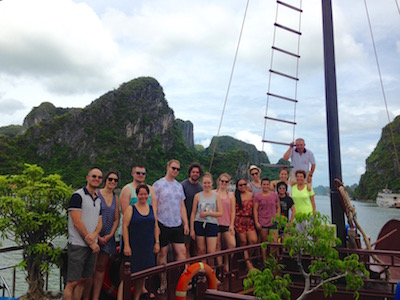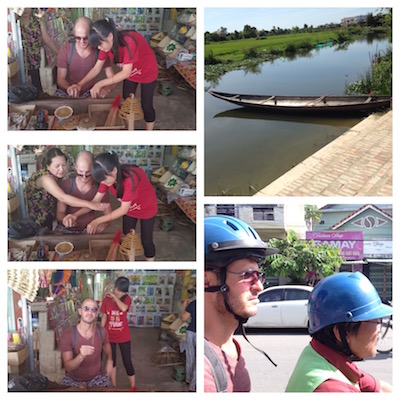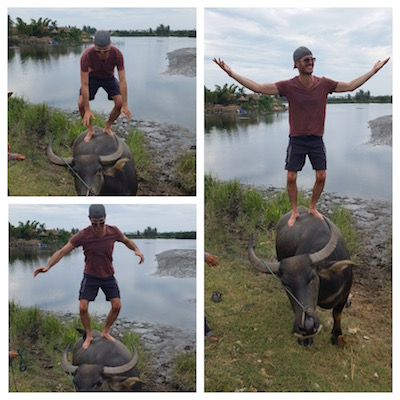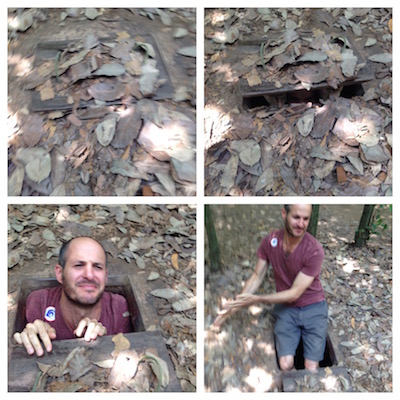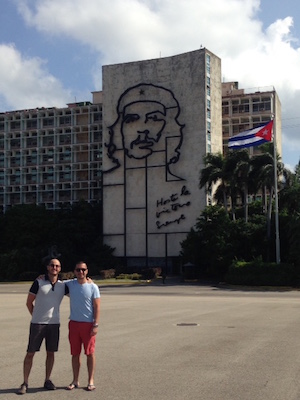Chào mừng! (I hope that means “welcome” in Vietnamese.)
Continuing eastward on my journey, I am now in Vietnam after a very lengthy 12-hour flight. I plan to explore the country from north (Hanoi) to south (Ho Chi Minh City), with plane, train, and automobile…and the occasional boat. For you visual types:

But first, a brief rant…
Rant
Delta Airlines: you’re awful. After waking up at 4am to take a train from Florence to reach Milan for my flight to Vietnam, I couldn’t check in at the airport. An airport customer service rep looked up my account and noticed Delta inactivated all my flights for the remainder of my trip. That’s certainly a new one. She called Delta and was put on hold immediately. (Meanwhile, she asked me if I happened to knew of a better number to reach Delta at!) After 15 minutes on hold – an eternity, when minutes are being counted – she finally reached someone who sadly couldn’t help us. Not because my situation was unusually complicated but because Delta didn’t pass 5th grade geography. Our side of the conversation went as follows: “Hello I’m calling from Milan International Airport and…yes, Milan…Meeeeelan…no, it’s in Italy.”
Ultimately I did make it to Vietnam – with only minutes to spare – but not without newfound resentment for Delta. Anyway, once I was picked up at the airport by my driver I forgot all about my troubles.
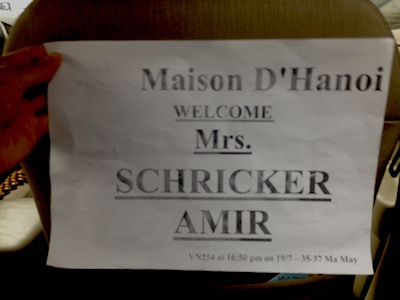
Food
Vietnam is often considered the culinary capital of Southeast Asia, even though Thailand tends to receive the mainstream attention. Touring the country from top to bottom will therefore offer a sampling of the country’s regional cuisine and, in turn, their culture. I’ve long felt the best way to learn a culture is through food, and so I’m excited to try everything from street stalls to upscale restaurants.
Vietnamese food can be characterized as “fresh and light”, neither of which are terms typically used to describe Asian cuisine. Their dishes are filled with piles of fresh greens and other fruits and vegetables, and the streets are packed with women transporting greens on their back, selling them, or cooking them right there on the sidewalk.
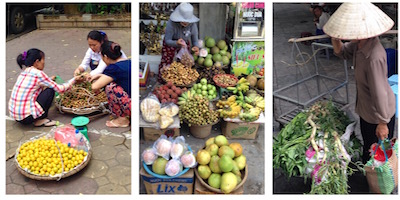
Don’t worry they have meat too, although the USDA would probably have a few questions about this setup.

Here are some other food highlights.
Pho
Vietnam’s most well-known dish is pho, or noodle soup with thin slices of meat and handfuls of fresh greens. It’s pronounced “fuhh” – like “fun” without the n – and not “foe”. Great pho depends on great broth, which involves many hours of cooking. Walking down the street of Hanoi smelling the aroma of pho is very tantalizing.
Even though I generally prefer other Vietnamese dishes, I certainly don’t dislike pho so my first goal here was to get a bowl. I ended up at Pho 2000, a local chain. (Yes, goofy name but sit tight.)
Simple as it may appear, it was…pho-nomenal! I was afraid the clear broth meant it’d be devoid of flavor, but not at all. This wasn’t their first time doing this.

Also it turns out that then-president Bill Clinton ate here in 2000. What the pho?!
(That too marked the first time an American president visited Vietnam since the war.)

That’s now three times I’ve followed Clinton: first for beer in the Czech Republic, then hot dogs in Iceland, and now this. Where will he lead me to next?
Street Food
If food is being sold on the street, chances are I’ll be standing in line for it. Lucky for me, Hanoi is known for being one of Asia’s great cities for street food.
“Restaurant” is a bit of a stretch for what these places are. They’re more like one-room shops where the food is being cooked in the corner or in front of the shop. In Vietnam they all have a propane or charcoal stove and seating is a table or tiny plastic stools. Most feature only one or two dishes that they have perfected and sell for ridiculously low prices. It’s a wonderful thing to walk in, take a seat, and soon have delicious food placed in front of you, all without saying a word.
My favorite in Hanoi was this place, which I ate at three times:

They serve only bun cha, very flavorful grilled meat with rice vermicelli noodles and a mountain of fresh greens. I wasn’t familiar with this dish before this trip, but I am a loyal fan now.
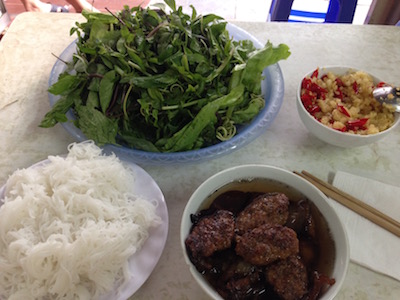
That bowl in the upper right isn’t rice…it’s chopped up chilies and garlic, and you know I loaded up on it. Although I had fierce garlic breath – and a churning stomach – afterwards, it was well worth it.
By the way, their “menu” is simply this poster on the wall:

The conversion rate is 1 USD to 20,000 dong, so bun cha is $3, beer $0.75, and water $0.50. Yes, beer is less than $1.
It’s Communist, but…
Vietnam’s political system is communist, and there’s no confusion there.

(Any place you see the Vietnamese flag (star, on the right), you’ll see the old USSR hammer and sickle flag next to it.) Their economy, however, has realized the benefits of a free market and thus capitalism is thriving here. And everyone is out to make a quick buck.
Case in point: when I landed in Vietnam I saw a non-official taxi driver approach an unsuspecting tourist asking if he wanted a taxi. The rogue taxi driver flashed him a ID card with a phony logo of the city’s official taxi company, so the tourist believed him and hopped in his taxi – his plain unmarked van, that is. Then, instead of being charged approximately 150,000 dong, the poor sucker was charged 700,000 dong.
In case you can’t tell, that poor sucker was me.
Halong Bay
I took an overnight trip to Halong Bay, a beautiful bay with more than 2000 limestone islands popping out of the water. It’s a UNESCO World Heritage site, and with some others we hopped aboard this boat:

One of the islands had a small temple at the very top that you can reach, but only after climbing up 430 steps. Normally that’s doable, but in this unbelievably hot and humid weather, it was grueling. Here’s a selfie from the top:
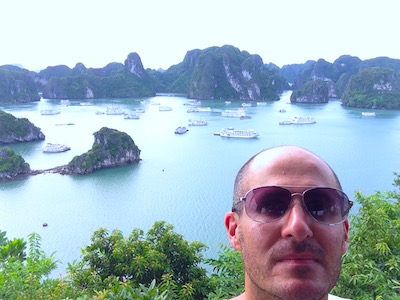
A fun — but damp — trip. Nothing ever fully dries on a boat. Come to think of it, I don’t think I’ve worn dry clothes for a month.
